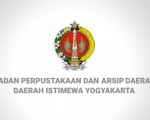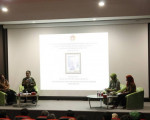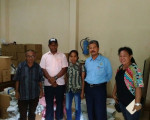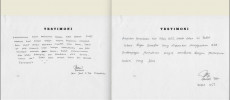members of its community for the management and dissemination of digital material created by associations and members of their community."
The definition according to Lynch applies to the college environment, because it implicitly states the university / college and its community. Institutional repositories are new concepts to be collected, managed, disseminated, and preserved scholarship works created in digital form by faculty and students at each university or college. Institutional repositories offer complete facilities, organization, access, distribution and preservation of digital content. Institutional repositories for tertiary articles include preprinted and printed journals, technical reports, papers, research data, theses, dissertations, work development, collections of images or photographs and important printed materials, lecture and training materials, and safety history research materials.
Institutional repositories describe the historical and tangible manifestations of intellectual life and partnership products, and institutional repositories have two main objectives, namely: 1. Providing open access to the results of institutional research by archiving the results of the research itself, 2. Saving and preserving other institutional digital assets, including literature that cannot be erased or easily lost.
Institutional repository becomes a significant indicator of the academic quality of a college. Institutional repository urges serious consideration for academic institutions and their components: faculty, librarians and administrators. Prosser and Crow, maintain their opinion that institutional repository can be an indicator of the quality of higher education, proving that scientific research activities, social, and have economic relevance, then increasing the visibility, status and public value of an institution.
Higher education is one of the institutions where the process of creating and transferring knowledge takes place. According to Nonaka & Takeuchi, there are four processes of knowledge transfer, namely socialization, externalization, combination and internalization. Socialization is the process of transfer from tacit knowledge to tacit knowledge, for example the dissemination of information among people by way of conversation. Externalization is the process of transfer from tacit knowledge to explicit knowledge, for example writing books, journals, magazines and articles.
Combination is the transfer of explicit knowledge to explicit knowledge, an example of this is for example summarizing the contents of a book. While internalization is the transfer of explicit knowledge to tacit knowledge, for example lecturers deliver courses based on textbooks. When discussing institutional repositories it cannot be separated from the understanding of knowledge management. Knowledge management starts from understanding how a knowledge is created to how its design involves many components. These components can be identified through a review of the philosophy of science.
Ontology is a branch of the philosophy of science and discusses what exists without being bound by certain manifestations. In this context, ontology is a way of representing knowledge about the meaning, property of an object, and relations of the object that might occur in the domain of knowledge. At tertiary institutions, there are four components of ontology preparation, namely the subject, knowledge, faculty, and laboratory headlines. The four ontology components initially did not have a relationship, to connect the four components were carried out mapping so that the four components of the ontology became interrelated with one another.
The development of information technology and computers has made the academic community have many choices in transferring and gaining knowledge. Lectures can be done with the help of the internet or known as e-learning. Interaction between the academic community within the academic sphere is also possible through existing social media, leading to reading and writing habits in social networks.
According to Hansen, Nohria and Tierney, one of the organizational strategies for managing knowledge is the codification strategy, which is when knowledge is translated in explicit form and stored in a database so that knowledge seekers who need it can easily access the knowledge.
Knowledge is formed based on the model: data, information, and knowledge. In the current digital era the process of converting from data to knowledge according to the model in organizations is mostly done with the help of technology. But knowledge management is more than just about technology, knowledge management is a social system. The intended social system is referring to a set of parts that collectively consist of more than one, interacting together in a complex form a system. In the process of social systems the collection, distribution and sharing of knowledge is possible and promoted. Converting information into knowledge requires a very different process than converting data into information.
The difference between institutional repositories, local content and gray literature, because errors often occur among Indonesian tertiary libraries with regard to these three terms. According to Sulistyo-Basuki, that local content is a publication about an area or institution, for example a book about Padang for a library in Padang is local content because it involves Padang while a dissertation on mathematical theory by the University of Lampung is not local content because it does not concern lampoung or University of Lampung While gray literature is published by a high institution or department in both print and digital form regardless of its format which cannot be obtained in the open market or bookstore. Therefore thesis, thesis and dissertation are included in Gray literature, but if submitted in digital form to the library, the library is an institutional repository. So institutional repository is an institution that stores an institution's publications in digital form, for example students submit their scientific work in digital form to the library, then the library is an institutional repository. Gray literature collected in institutional repositories either through the process of transferring them.
Conclusion
Library repository is an online library collection storage for collecting, organizing and distributing library collections in digital form, which is the production of institutions, especially research results. The benefits of the repository are as follows: 1. To gather scientific research on academics in one digital storage so that it can be easily found again, either through Google or other search engines. 2. To provide open access to scientific research produced by the academic community and reach wider society with unlimited space and time. 3. To increase the impact of scientific research produced by the academic community. 4. To promote scientific research produced by academics. 5. As a storefront and safe storage for the results of academic community research. 6. To provide a long-term library collection for scientific research results of the academics. 7. If there is plagiarism of scientific research published in the Institution Repository it will be easily known and found. 8. To link the publications of academics or researchers from their web pages, the personal web of lecturers or researchers.
Bibliography
Farida, Ida, et al. "A conceptual model of Open Access Institutional Repository in
Foster, Nancy Fried, and Susan Gibbons. "Understanding faculty to improve content recruitment for institutional repositories." Online Submission 11.1 (2005);
Jianzhong, Wu. "Library vs. Institutional Repository [J]." The Journal of The Library Science In
Robertson, Wendy C., and Carol Ann Borchert. "Preserving content from your institutional repository." The Serials Librarian 66.1-4 (2014);
Sulistyo-Basuki, L. "Digitisation of collections in Indonesian academic libraries." Program 38.3 (2004);
Walters,
Perpustakaan Lainnya
 Library Excellent Services for Millenial Generation
Library Excellent Services for Millenial Generation
Library Excellent Services for Millenial Generation Writer: Hendrikus Franz Josef, M.Si Regional...
 BEDAH BUKU “SRI SULTAN HAMENGKU BUWONO IX : LANGKAH DAN KEBIJAKAN BAGI KESEJAHTERAAN ABDI DALEM”
BEDAH BUKU “SRI SULTAN HAMENGKU BUWONO IX : LANGKAH DAN KEBIJAKAN BAGI KESEJAHTERAAN ABDI DALEM”
Grhatama Pustaka kembali menyelenggarakan acara bedah buku pada hari Jumat, tanggal 18 Maret 2016. Acara bedah buku tersebut...
 PERMENPAN&RB NOMOR 13 TAHUN 2019: TIDAK ADA PEMBERHENTIAN SEMENTARA KARENA ANGKA KREDIT
PERMENPAN&RB NOMOR 13 TAHUN 2019: TIDAK ADA PEMBERHENTIAN SEMENTARA KARENA ANGKA KREDIT
Pada minggu ini di kalangan fungsional Pustakawan DIY mulai ramai diperbincangkan terkait terbitnya peraturan yang meniadakan...
 Kunjungan dari Badan Perpustakaan Arsip dan Dokumentasi Kabupaten Raja Ampat Papua Barat
Kunjungan dari Badan Perpustakaan Arsip dan Dokumentasi Kabupaten Raja Ampat Papua Barat
Selasa 21 juni 2016 BPAD DIY mendapatkan kunjungan dari BadanPerpustakaan Arsip dan Dokumentasi Kabupaten Raja Ampat Papua...

 Kegiatan Penyususnan Katalog Induk Daerah (KID)
Kegiatan Penyususnan Katalog Induk Daerah (KID)